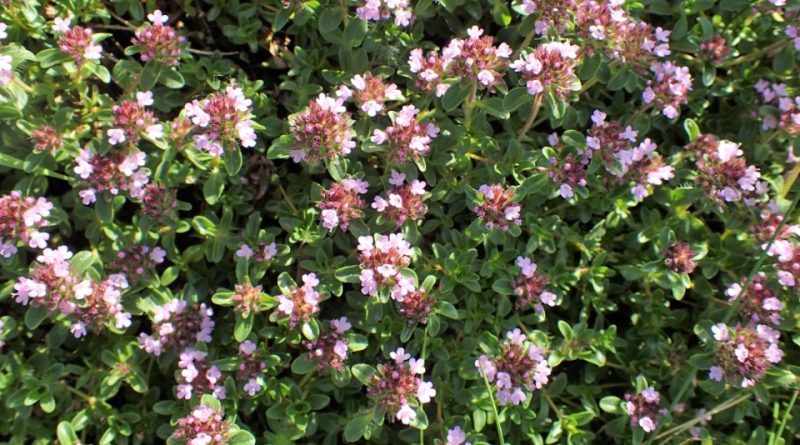Thymus alpestris
Thymus alpestris
Alpine Thyme (Thymus alpestris Tausch ex A. Kern., 1881) is a perennial species of the Lamiaceae family.
Systematics –
From a systematic point of view, it belongs to the Eukaryota Domain, United Plantae, Sub-Tracheobionta, Spermatophyta Superdivision, Magnoliophyta Division, Magnoliopsida Class, Asteridae Subclass, Lamiales Order, Lamiaceae Family, Mentheae Tribe and therefore to the Thymus and the T. alpestris species.
The terms are synonymous: Thymus alpestris f. albiflora Sigunov, Thymus alpestris var. opizianus P.A. Schmidt, Thymus alpestris var. rubescens Ronniger, Thymus chamaedrys var. alpestris (Celak.) Celak., Thymus serpyllum f. alpestris Celak., Thymus serpyllum f. formosus Lyka, Thymus serpyllum f. orbicularis Lyka, Thymus serpyllum f. serta-saxorum Lyka and Thymus subalpestris Klokov.
Etymology –
The term Thymus comes from the Greek θύμον thýmon timo, a generic name that derives from an ancient Greek name used by Theophrastus (371 BC. – Athens, 287 BC) for a fragrant plant used as incense in sacrifices. The specific epithet alpestris is in reference to the Alps, alpine, alpine. Some texts of etymology distinguish between alpinus, relative to the altitude band beyond the plant boundary, and alpester, the underlying altitudinal strip, but the authors of the new species did not follow this subdivision.
Geographical Distribution and Habitat –
Alpine thymus is a very rare species that is found most frequently on the northern slopes of the Alps. On the other European hills connected to the Alps it is found in the Black Forest, Vosges, Jura Massif, Massif Central, Pyrenees and Carpathians.
Its typical habitat is the dry meadows and the prairies spread from the hilly to the subalpine level, also the rocky and rocky prairies, including meadows and mesophilic pastures where it grows preferably on calcareous substrate but also siliceous with neutral pH and low nutritional values of the soil which must be dry. It is a species that can be up to and above 1500 m asl.
Description –
Thymus alpestris is a species that can reach heights of 8 – 15 cm, with oscillations from a minimum of 5 cm to a maximum of 30 cm. It is a plant that stands out for the growth of the organs adherent to the ground, with a creeping character.
The roots are secondary to the rhizome with an aerial part of the stem that is pseudo creeping or rarely creeping. The stem is tetragono, with a quadrangular section, due to the presence of collenchyma bundles placed in the four vertices. The surface is covered with hair.
The leaves are petiolate, placed along the stem in the opposite way and have a varied shape ranging from ovate to lanceolate with progressively enlarged shape towards the apex and with leathery consistency and glabrous surface.
The inflorescences are formed by some flowers gathered in whorls, terminal, spicere erected in the shape of a spherical to ovoid (the inflorescences are found in the upper portion of the stems), with bracts similar to the leaves.
The flowers are zygomorphic hermaphrodites, tetramers (4-cyclic), that is with four whorls (calyx – corolla – androceo – gineceo) and pentameri (5-meri: the corolla and the calyx, or perianth, are 5 parts).
The anthesis is in the period from April to August.
The fruit is a schizocarp composed of 4 dried nuculas (tetrachenium), with ovoid to oblong forms, with smooth and glabrous surface, with poor or absent endosperm. In this plant there are essential glands.
Cultivation –
For the cultivation of this species it must be considered that its natural habitat is that of calcareous or siliceous soils with neutral pH and poor in organic substance. The species also prefers cool climates while for a good production of essential oils it is necessary that it is grown in full sun.
The plant should therefore be sown on light and sandy soil. When the seedlings are sufficiently developed, they must be transplanted into pots or full earth, in sunny areas without water stagnation. The plants can be reproduced by cuttings or division of the tufts.
As far as irrigation is concerned, the plant, thanks to its root system, is able to grow with only the rains and in any case the irrigation supplies must only be of help and away from the time of collection of the green parts.
Uses and Traditions –
The alpine thyme, although it is part of the numerous and complex genus of the Thimus, has its specificity linked to the composition of its essential oil. It contains monoterpenes of the biosynthetic pathway of phenol (which is also common in other species); they are contained, with variable percentages also depending on the collection area of the thyme and the season: γ-terpinene, p-cymene, β-caryophyllene, thymol and carvacrol. Moreover, the variability of essential oils is also linked to the fact that in Italy this plant it is easy to find it as an intermediary with the Thymus praecox Opiz species. and Thymus pulegioides L ..
As with other thyme species, Thymus alpestris also has therapeutic properties: digestive, purifying, carminative, balsamic, tonic-stimulating; for gargling oral infections.
Preparation Mode –
Even the alpine thyme can be used in the kitchen to flavor and make many foods more digestible, such as roast meats, sauces, vegetables, mushrooms, fillings, aromatic oils and vinegars. It can also be used to prepare liqueurs and aromatic wines.
For use it is necessary to remove the leaves and the flowering branches and to dry them in a shady and ventilated place.
Guido Bissanti
Sources
– Acta Plantarum – Flora of Italian Regions – Wikipedia, the free encyclopedia – Treben M., 2000. Health from the Pharmacy of the Lord, Advice and experiences with medicinal herbs, Ennsthaler Publisher – Pignatti S., 1982. Flora d ‘Italy, Edagricole, Bologna. – Conti F., Abbate G., Alessandrini A., Blasi C. (edited by), 2005. An annotated checklist of the Italian vascular flora, Palombi Editore.
Attention: Pharmaceutical applications and food uses are indicated for informational purposes only, do not in any way represent a medical prescription; therefore no liability is accepted for their use for curative, aesthetic or food purposes.


